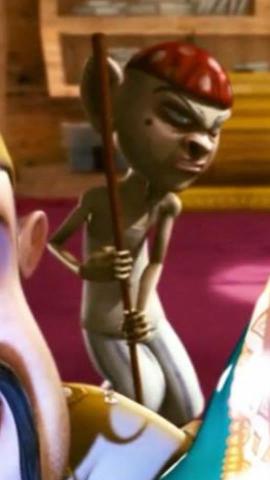Children’s media can be particularly difficult to critique because it’s simple by design. A plot or joke an adult has heard a million times is a new experience to a child. Additionally, not every studio has the money and support of a Pixar or Studio Ghibli. As someone who loves pop culture, I want all of it to be “good,” even as I recognize that the definition of “good” varies and that often parents put on a movie or show because they are tired or otherwise need to occupy their kid for a bit. My mom certainly did that with me.
Still. Just because a piece of media is for children doesn’t mean we should automatically accept that it’s of low quality.
Toonpur Ka Super Hero is of low quality. Taken individually, its parts might be acceptable, but added together, it’s a mess: cheap looking animation, extremely stereotyped characters, incredibly sexualized female characters, lackluster songs, and a muddled plot. Kajol is great, though.
First, let’s look at the character design:

Goofy looking, bright colors, clearly several different archetypes with different personalities and roles. But who is this?

Oh no. And surprise, his name is Gossip and he’s secretly working for the bad guys. Here are the bad guys:

We should ask ourselves, what messages are kids receiving from TVs and movies? When they see villains designed in such a way, what do they learn?
And let’s not forget about Lovina and Monica, because that’s impossible:


When children see hypersexualized female characters, of course they will view women as objects. These women are only to be looked at, to be characterized by their bodies. The male characters are largely jokey buffoons, but at least they are more than just a body part.
The first Smurfs animated movie also came out in 2011, and features similar design problems:

An animated character should be easily recognizable, so it makes sense to distill a character down to a single trope. But the male characters get to be goofy, weird, geeky, musicians, Scottish (?), the female character is beautiful, and only beautiful.
Oh, the other female character in Toonpur Ka Super Hero?

She is constantly talking about food and uses a rolling pin as a weapon. If you are not young and beautiful, you are a fat joke and still limited by the typical implements of womanhood. Not every movie has to be an exercise in critical thinking, but I still want positive representations and messages.
The movie is remarkable for being the first Indian live action/3D animation movie. The central conceit is pretty good: a human man is kidnapped and taken to the cartoon world, where he must defeat the villain.
However, a central conflict hinges on the toons being angry with Aditya (Ajay Devgan) for not wanting to help them. They kidnapped him in the first place, so why should he be eager to help? Likewise, the move follows the well-worn trope of “dad busy with career ignores family.” His career that pays for their nice house and pool. And it’s clear he loves his kids. Aditya doesn’t need a lesson in love, affection, or family, maybe just in figuring out a better work-life balance.
Additionally, Kabir (Amey Pandya) is upset that not only does his father work long hours as a movie star, but that he’s a fake hero: Aditya uses stuntmen. Kabir is happy in the end when Aditya defeats the villain, but I’m not entirely convinced that’s “real” either since it’s in the cartoon world.
Kabir’s mother, Priya (Kajol) actually does share a positive message: being a hero isn’t about a cape and super feats of strength but about loving and providing for family. Though at the end of the film, love translates in to feats of strength.
And our favorite question: is the movie feminist? No. I mean, one could stretch — there are are multiple female characters of various ages and social classes. Priya helps Aditya save their daughter. But the focus is squarely on a male character, and somewhat on the relationship with his son; the daughter in particular does little, and Priya helps a little but ultimately the big strong man saves the day. Still, I guess, the movie earns a few points for having more than one female character. The first Cars movie, 2006, has just one female character of note (and a few much smaller roles), and she’s a love interest.
Ultimately, the movie is fine. The character design pushes it into “awful,” but the plot and performances are fine as a distraction for a few hours.